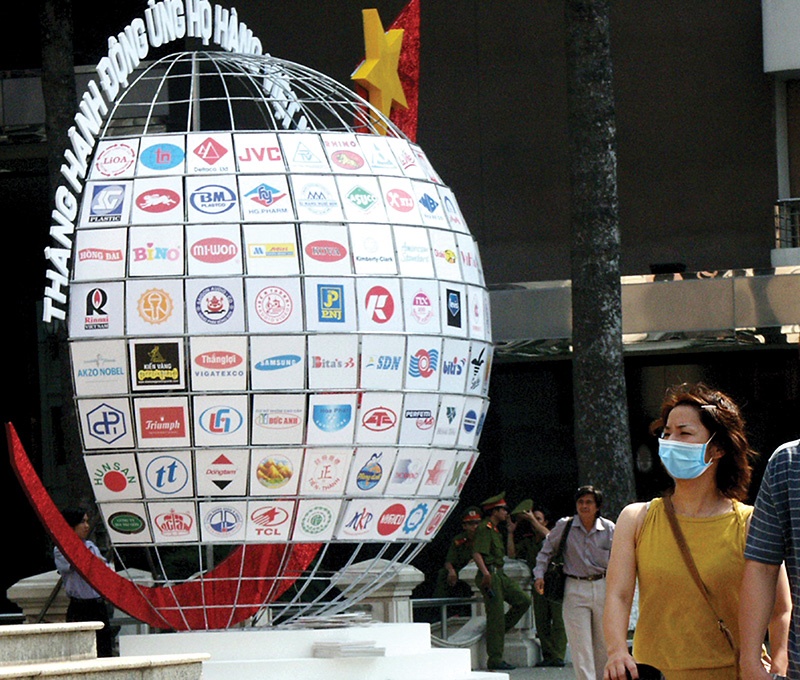The risks from improper use of registered trademarks
 |
| Nguyen Vu Quan from KENFOX IP & Law Office |
In recent times, there have been disputes caused by improper trademark use. Last month, the People’s Court of Ho Chi Minh City heard the dispute between plaintiff Dong Phuong Trading and Manufacturing Co., Ltd and the defendant, Asanzo Vietnam Electronics JSC. The plaintiff sued the defendant on the grounds that the defendant’s use of the sign “ASANZO, device” violated the plaintiff’s trademark “ASANO, device”.
Rejecting the plaintiff’s claim of infringement, the defendant stated that the defendant’s use of the trademark “ASANZO, device” is legal because the Intellectual Property Office of Vietnam (Vietnam IPO) granted registration for the trademark “ASANZO”. Although the defendant’s trademark “ASANZO” was protected, it was being used with considerable alterations to its initially registered representation, thus making it more similar to the plaintiff’s mark than the actual owner’s mark.
And so the court determined that the defendant’s use of the sign “ASANZO, device” constituted an infringement of the plaintiff’s protected mark, compelling the defendant to cease the infringement, publicly apologise and rectify, and pay VND100 million ($4,350).
Another case is trademark cancellation due to improper use. A third party filed a non-use cancellation against a registered mark “TWITTER BEANS COFFEE. ON YOUR HANDS” which comprises the verbal and figurative elements. The trademark owner submitted evidence of use to rebut non-use cancellation.
However, after considering the facts and evidence of use of the mark, Vietnam IPO issued a decision cancelling the validity of a Vietnamese trademark registration on the grounds that the trademark owner’s evidence of use does not reasonably establish that he used the mark as registered since the mark in actual use by the trademark owner constituted a variation of the registered mark, namely “TWITTER BEAN COFFEE” without the figurative element.
 |
| Branding issues can be a tricky business if a country does not have robust regulations in place, photo Le Toan |
The risks due to improper use
The first one is the risk of infringing on another’s trademark. The use of a mark means the act of affixing a mark to goods or means of service in order to assist consumers in distinguishing goods/services of the same type produced by different entities. Thus, the mark’s primary role must be to identify the commercial origin of the goods/services bearing the mark.
After being granted registration, the owner has the right to “affix” the mark to the goods/services registered under that mark to conduct commercial activities in Vietnam.
The defendants in all the cited cases have registered their marks in Vietnam. Thus, from a legal standpoint, these defendants have the right to use their registered marks to commercialise their products in Vietnam. However, the use of the mark must be within the scope of the trademark protection which depends on the mark image as registered and the list of goods/services identified in the trademark registration certificate. This means that even if the mark is registered, misuse of the mark may make the mark go beyond the scope of legal protection.
Vietnamese law does not specifically provide that the owner must use the mark as it was registered. However, if the use of a trademark exceeds the scope of its protection, exposing the relevant consumers to the risk of confusion, you may be exposed to many risks. It’s worth noting that, in addition to administrative sanctions, the rights holder can also seek compensation for material and moral damage, apology, and public correction via civil route. No one wants to risk their company’s reputation or lose customer loyalty to a brand only due to improper trademark use.
Another risk is lost trademark rights. Improper use of a trademark can put you at risk of losing your trademark rights. A third party may petition the Vietnam IPO to cancel a registered trademark if such mark has not been used by the trademark owner or by the person authorised by the trademark owner for a period of five consecutive years from the date of registration.
Using a trademark that is dissimilar to the registered one may mean that you have not used the registered trademark. Therefore, in this state, proof of use of the mark may be rejected by the Vietnam IPO, putting your registered trademark at high risk of being cancelled for reasons of non-use.
Vietnamese law and practice do not have a clear definition of “proper use of trademarks”. However, as a party to the Paris Convention, for the proper use of the mark, one can refer to Article 5.C.2 of the Convention, according to which, in principle, the trademark owner can use a mark in a different form, provided that such a mark does not “alter the distinctive character of the mark in the form in which it was registered”, it will not “entail invalidation of the registration and shall not diminish the protection granted to the mark”.
The purpose of this provision is to enable trademark owners to modify their marks without impairing their unique character, thereby adapting the mark to the marketing and promotion of connected goods or services. However, the alteration must be in indistinguishable elements, and the sign(s) used in practice and the registered trademark must be fundamentally the same.
Exactly as registered
Practice indicates that in general, a trademark owner can make some changes in typeface, stylisation, design, and colour to a registered trademark without negatively affecting the validity or scope of protection of the mark if such changes do not alter the registered mark’s distinctive character. A trademark owner may omit or add an element to his registered mark if such added/omitted element is not distinctive, or has “weak” or unremarkable/dominant distinctiveness.
In this situation, such added/omitted element does not change the distinctive character of the registered trademark and thus, the actual use of the mark (with an element being added to or omitted) may be considered as the use of the registered mark or may suffice to cover the registered mark.
The law of Vietnam does not guarantee that, in the event of the use of a sign that is similar to a trademark registered by the owner himself, such trademark owner is exempt from accusations of trademark infringement from other organisations/ or individuals, which is demonstrated by cases described above.
A sign other than a registered trademark shall be considered as an independent sign, unrelated to the registered mark. To determine whether an infringement of another’s trademark has occurred, the Vietnamese enforcement agency only needs to determine that the following three conditions are satisfied: similarity/identity of a sign to a protected trademark; similarity or identity of the goods/services bearing the sign with those bearing the mark; and permission of use of the mark and likelihood of confusion about the commercial origin of the trademarked goods and services.
From the above, it can be seen that the trademark owner can still use a mark in a form different from the registered one under certain conditions, namely by taking two evaluation steps. The first step is assessing registered trademarks, as it is necessary to consider which factors are distinguishable and have strong visual impressions.
The second step is assessing the difference of the mark in practice and the impact of the changes. It is necessary to assess whether the factors contributing to the distinctive character of the registered mark are present and/or the modification in the mark in actual use, by directly comparing the two marks, in order to determine the degree of difference between them.
Additionally, to mitigate risk, we recommend the following strategies:
- The mark should be used as registered;
- It must be ensured that the distinctive characteristics of the registered mark are not altered if a mark in actual use is different from the registered one.;
- If the mark in actual use is substantially different from the one previously registered a new application should be filed for registration of such mark;
- Copyright registration at the Vietnam IPO may be considered if the applicable requirements
are met;
- Availability searches should be conducted for the marks in actual use different from the registered one in order to identify similar marks (if any);
- Validity of the similar marks found in the availability searches may further be challenged; and
- Assessment conclusion on the likelihood of trademark infringement may be obtained at the Vietnam Intellectual Property Research Institute.
The cases above and the current provisions of Vietnamese IP law cannot help determine or find a definite answer as to whether altering a registered mark may or may not entail risks. Obviously, when considering whether to make changes to a registered trademark, case-by-case facts must be carefully considered before a risk assessment can be made.
What the stars mean:
★ Poor ★ ★ Promising ★★★ Good ★★★★ Very good ★★★★★ Exceptional
Related Contents
Latest News
More News
- Human-centred governance seen as key to AI development (December 19, 2025 | 18:19)
- Top 10 notable events of Vietnam’s industry and trade sector in 2025 (December 19, 2025 | 14:00)
- Tungsten surges to 12-year high as world enters a new 'black gold' race (December 18, 2025 | 17:27)
- Vietnam’s coffee exports set new record despite price pressures (December 18, 2025 | 17:13)
- Garment and textile sector seeks new growth after volatile year (December 18, 2025 | 17:01)
- VinSpeed and Siemens strengthen cooperation for high-speed rail development (December 18, 2025 | 16:53)
- High-tech adoption for TH true MILK (December 18, 2025 | 13:39)
- Takeda supports health resilience amid climate change challenges (December 18, 2025 | 12:39)
- Mondelez Kinh Do - a chapter of purpose-led leadership in Vietnam (December 18, 2025 | 09:44)
- VNPAY services receive the highest-level PCI DSS international security certificates for six consecutive years (December 17, 2025 | 23:47)

 Tag:
Tag:
















 Mobile Version
Mobile Version